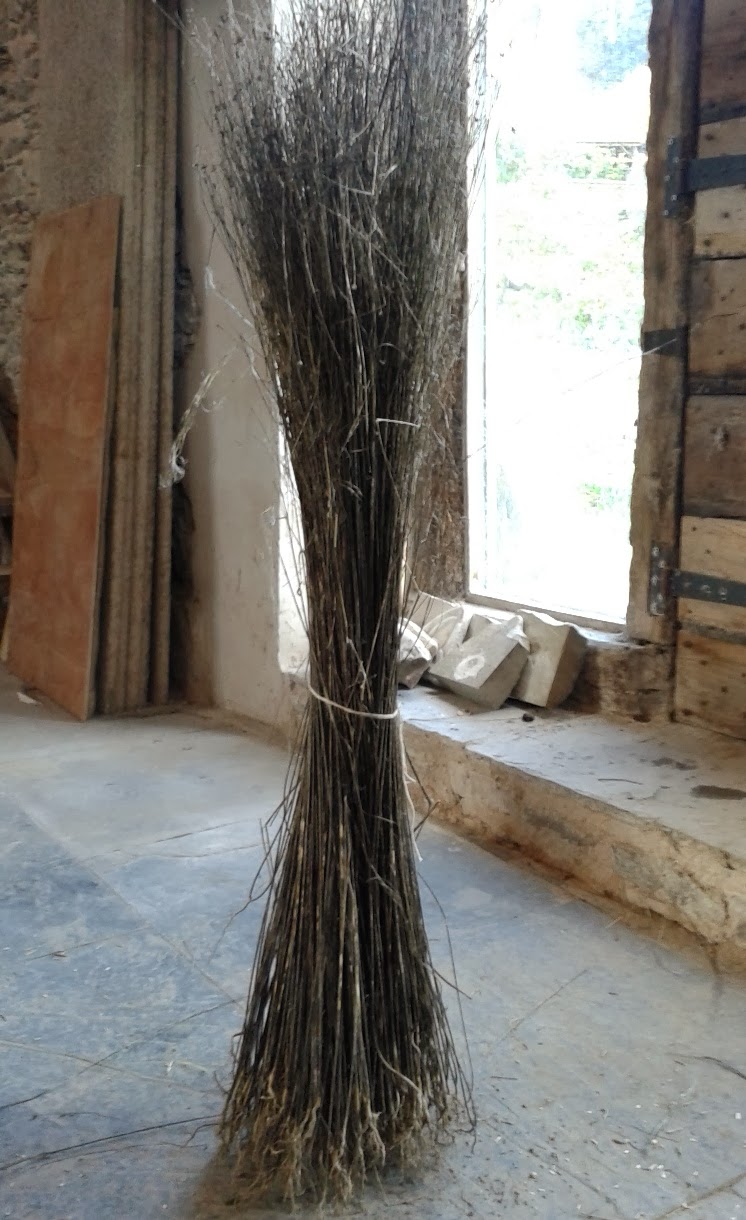In recent months I’ve been growing flax as part of a work-related project, and having successfully raised our first crop, I’m now having to learn how to process it to produce the flax fibre from which we can produce linen cloth (and linen rope). If you are interested in the project, see my update on Flax processing on the Worcestershire Young Archaeologists Allotment.
What is Warp-weighted Linen?
Having tried spinning of flax to make linen yarn some time ago, whilst learning to spin with wool, I’ve also become curious about weaving and the ancient craft of weaving on a warp-weighted loom. It is the tradition from which all weaving developments have sprung in the British Isles and much of Europe, the loom having not changed much until the medieval period. It’s also an ideal activity for the Young Archaeologists to try with their new flax product. How convenient then that I should come across a workshop which covers warp-weighted weaving and flax processing. So, off I went, a couple of weeks ago to Llanidloes in mid-Wales. The workshop was hosted by Cambrian Archaeological Projects, and the tutor was Shirley Elwell of Slender Thread.
It’s a time-consuming and involved process just to produce this……

First the crop needs to be harvested and dried.

Retting
Then we need to ret the stems. This means rotting so that the outer part of the stems disintegrate, exposing the fibres. We are dew retting our flax which means leaving it to rot on the ground for several weeks.
At the workshop we started with retted flax. It is surprising how quickly the following stage (breaking) transforms something that looks very definitely plant like to something reminiscent of fibre or even hair, rather like a pony tail from a pony that has been dragged through a hedge.
After all, it still needs some refining. Although it might not seem so from the photographs, it’s a very dusty job, as we soon found out. We confined ourselves indoors to a barn to do this, to flee the wet weather outdoors, and donned the dust masks for the first stage.

Scutching
With our floppy ‘pony tail’ in tow, we ‘scutched’, using a flat wooden beater to swipe away some of the outer plant stem (boon).

Heckling
With the coarse boon removed, a first stage of heckling involved brushing it through a pad of nails in a board to remove more boon and any short brittle fibres called the tow. We can use tow is to make rope, which is where the phrase ‘towing the line’ comes from.

With more heckling, using combs attached to a board, our fibres became gradually more silky and flaxen hair like.

Some enthusiastic heckling from Roy….

With some final combing with fine combs our sample of flax was processed and ready to prepare for spinning. In the process we lost some of our flax on the way, a necessary part of the process. It ended up in the tow box.
Practice Makes Perfect
We had flax from different crops to work with and we had chosen a batch that proved to have been slightly over-retted, so that some of the fibres had become brittle, leaving short lengths (more than expected), good for nothing more than making tow rope.
I should have taken pictures of our group holding up their samples of flax, some with crest-fallen faces. It just goes to show how critical it is that we get the retting process right. That we judge well the point at which we’ve sufficiently retted the crop.
Young Archaeologist Club Flax
At the weekend, back at the allotment, based on what I’ve learnt at the workshop, I judged that we’d retting flax to the right degree for processing. At least I hope I’m right. I stood some up to dry in the shed with the intention of testing some by ‘breaking’.
There is more to come on spinning flax and the warp-weighted weaving. For now, though, I’m off to the allotment to check on progress with drying the retted flax. With some final combing with fine combs, we’d processed our sample of flax and we’d prepared it for spinning.


I am so impressed by your successes–and let us pass over failures quietly, they are hard enough to bear without comment! I love all that home made equipment–it looks like you've made your own for purpose and it is really successful. Thanks for documenting the process. It's good to see all those steps and the final product!
It was a very useful workshop, and the hand-made tools were lovely. I only wish the tools were mine, but they belonged to the tutor (Shirley Elwell), made by her husband. I might have to make do with more rudimentary tools for now until I can re-create something similar. I already have my eye though on some woody undergrowth next to the Young Archaeologists' allotment, and my own, to make a loom similar to the one which will feature in the next post. Here's to successes after a little experimentation. Good luck with your continuing nettle processing…..